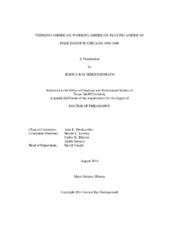| dc.description.abstract | Examination of folk dance in the Chicago area from 1890 to 1940 reveals the centrality of the body to ideas about education in the early twentieth century. The dissertation illuminates the circulation of folk dance practices in higher education and settlement houses in Progressive Era Chicago in conjunction with the influences of gender, ethnicity, and race. Folk dance satisfied both white, native-born, middle-class American nostalgia for an imagined rural past and immigrant desire to retain ties to homelands. Women social workers and teachers promoted folk dance as a healthful exercise and an avenue of insight into other cultures while also presenting it as an embodiment of American values. Extension of the study into the interwar period (1920-1940) permits analysis of both the persistence of progressive ideologies concerning the body as practiced through folk dance and the central role of women in physical education.
Over six chapters the dissertation address three primary points. First, it argues for the consideration of folk dance as an integral part of the physical education of children and young women as well as its function as an element of defining American-ness in both higher education and social settlements. Second, the dissertation demonstrates the prevalence of women as innovators in education, specifically through physical education curricula in colleges and universities. It also shows the connections between higher education and social settlements as two sites for learning that incorporated similar ideas about folk dance. Third, the dissertation assesses how Chicago, as a progressive center, facilitated the circulation of a set of folk dance practices grounded in Old World nostalgia and reframed it as part of the way to learn how to achieve a proper American body through similar curricula, instructors, and performances. Sources examined include records from colleges and universities such as course catalogs, programs, yearbooks, and campus newspapers; materials from social settlements, for example histories, programs, activity announcements, workers’ reports, and scrapbooks; personal papers of settlement workers and folk dance instructors; and folk dance manuals. | en |


